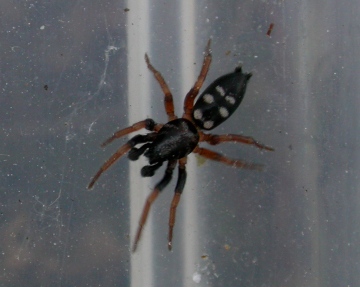Summary for Phaeocedus braccatus (Araneae)
previous species | next species
National Distribution
Terms of Use. Double-click on map to go to region

Explore Regional Distribution
Please log on and add a note on this species
About this species
Recorded altitude range1m to 160m
Species text
DistributionThe species is confined to southern England. It is widespread in western and central Europe as far north as Sweden, but local.
Habitat and ecology
P. braccatus occurs mainly on calcareous grassland, especially near the coast, usually in sparsely vegetated areas or under stones. It is also occasionally found on sparsely vegetated dry heathland in the New Forest, or coastal shingle in Suffolk, and in woods. Adults have been recorded from June to September.
Status
The spider is very local although it may be frequent at some sites on calcareous grassland. It is recorded from a total of ten locations in eight hectads since 1992. Although southern heathland has been poorly recorded in recent times, this is an unmistakable species which is unlikely to be overlooked, and records indicate a major decline since the 1950s. Area of occupancy has declined by 47% from 15 hectads before 1992 to eight hectads since then.
Threats
The loss of calcareous grassland to agriculture, and reduction of grazing.
Management and conservation
Maintain open, stony and sparsely vegetated areas on calcareous grassland by grazing. Some of these areas probably remain open and stony anyway because of lack of soil.
Text based on Dawson, I.K., Harvey, P.R., Merrett, P. & Russell-Smith, A.R. (in prep.). References
Adult Season
Habitats
background methodology
Recorded management for locations with Phaeocedus braccatus
Recorded substrate and hydrology for locations with Phaeocedus braccatus
Images
please log on and upload a new image for this speciesSee also A-Z Species Index - A-Z Picture Index - previous species | next species


